In this past weekend’s newsletter I discussed the market hitting “the wall” last week. This failure at the downtrend resistance keeps us on a defensive posture for now, but still allocated to the market as the longer-term bullish trend remains intact.
I know. It’s confusing.
However, this is the difficultly in navigating potential turning points in the market. It is also the juncture where the majority of investing mistakes are made.
This week, I want to review 5-indicators we are currently watching very closely. Importantly, these are NOT “market-timing” indicators as they are based on longer-term time frames and are slow to change. However, they do have a very strong record of determining important turning points in the market from “bull” to “bear.”
Since we are longer-term investors, our portfolio management process is driven less by short-term volatility, although we do hedge for such, and more towards changes in the trend of prices. While such analysis is “less predictive” and “more reactive” it is important to act accordingly within the portfolio management process when “signals” are issued.
The Stock-Bond Ratio
Something that should be of little surprise to anyone is the relationship between interest rates and equities. When interest rates rise, particularly sharply, it negatively impacts the costs of borrowing, the valuation of capital expenditures from the return on investment, and consumption. This eventually translates into slower rates of economic growth, not to mention recessions, which ultimately translates into a repricing of equity valuation.
The chart below shows that every time rates have reached the top of the long-term downtrend; the market has been impacted within the next 12-month period. Currently, that level on the 10-year Treasury is just a little above 3% on a log-scale.
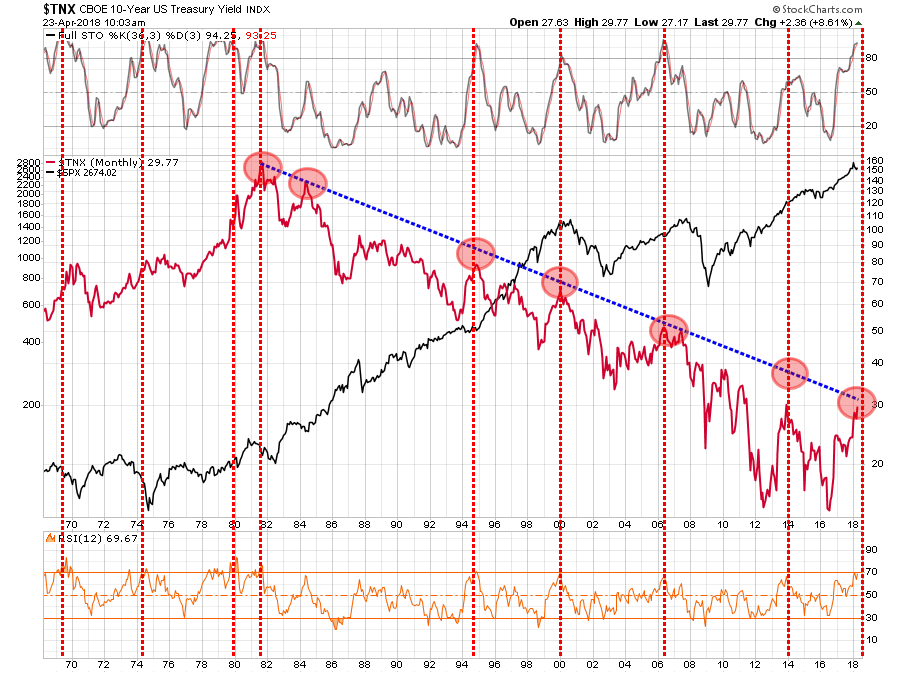
One way to see this relationship more closely is by looking at the ratio between stocks and bonds. Again, we see that when the ratio, the difference between $SPY and $TLT, is at exceedingly high levels, it has been a good indication of more important inflection points in the market.
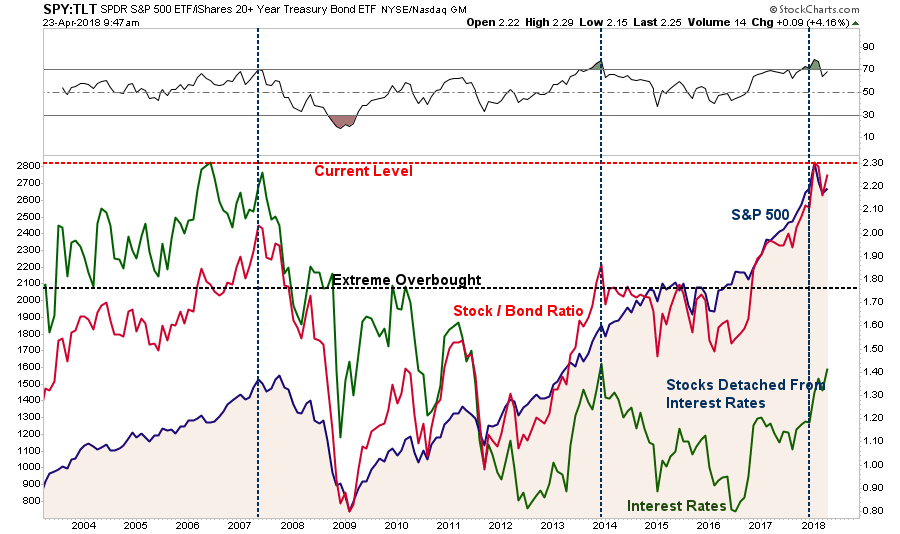
The next series of charts focuses on the S&P 500 index and related price indicators on various time scales. Again, as I stated above, we are looking at very long-term measures (quarterly, monthly and weekly) to determine potential changes in market dynamics. This analysis should NOT be used to make shorter-term trading decisions as these indications will take some time to develop.
As noted, this is where the majority of mistakes are made by investors as in the short-term (days and weeks) the market can certainly seem to defy the analysis. It is at this point where much of the analysis is dismissed under a “this time is different” scenario. However, these signals have, more often than not, given investors “fair warning” to modify inherent portfolio risk.
Quarterly RSI
Quarterly analysis is only useful on an extremely long-term basis as it is extremely slow to change as the data is only valid as of the end of each quarter. However, since the first quarter of 2018 recently ended, we can take a look at the relative price measures for an update.
The top part of the chart is the 3-year relative strength indicator. Via Stockcharts.com:
Developed by J. Welles Wilder, the Relative Strength Index (RSI) is a momentum oscillator that measures the speed and change of price movements. RSI oscillates between zero and 100. Traditionally, and according to Wilder, RSI is considered overbought when above 70 and oversold when below 30. RSI can also be used to identify the general trend.
Currently the RSI is registering levels of “overbought” conditions that have only been seen a few times in history. At every one of these points the market has experienced a correctionary period. What separated the price correction from just a “correction within an ongoing bull trend” and an outright a “full-blown mean reverting event” resides on valuation levels when signals were triggered. With valuations currently at the second highest level in history, one should be able to surmise the most likely outcome.
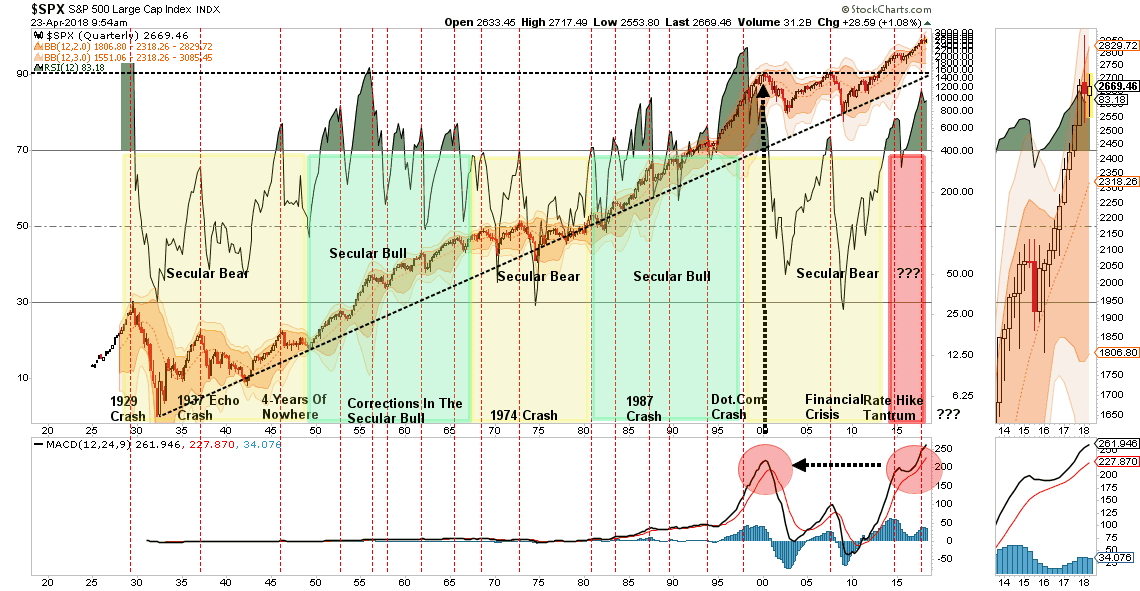
Monthly MACD
If we look at “monthly” price indications we can speed up the signals a bit. This chart looks at the Moving Average Convergence Divergence (MACD) of the 3-year moving average (bottom panel). Via Stockcharts.com
Developed by Gerald Appel in the late seventies, the Moving Average Convergence/Divergence oscillator (MACD) is one of the simplest and most effective momentum indicators available. The MACD turns two trend-following indicators, moving averages, into a momentum oscillator by subtracting the longer moving average from the shorter moving average. As a result, the MACD offers the best of both worlds: trend following and momentum. The MACD fluctuates above and below the zero line as the moving averages converge, cross and diverge. Traders can look for signal line crossovers, centerline crossovers and divergences to generate signals.
Importantly, while the actual signal to occur provided sufficient warning to protect capital, the current signal combined with extreme overbought (top panel) conditions and deviations (3-standard deviations of 3-year average) has not previously been linked to “bull market” continuations. With both quarterly and monthly measures suggesting much higher levels of capital risk, the question of “timing” becomes more important.
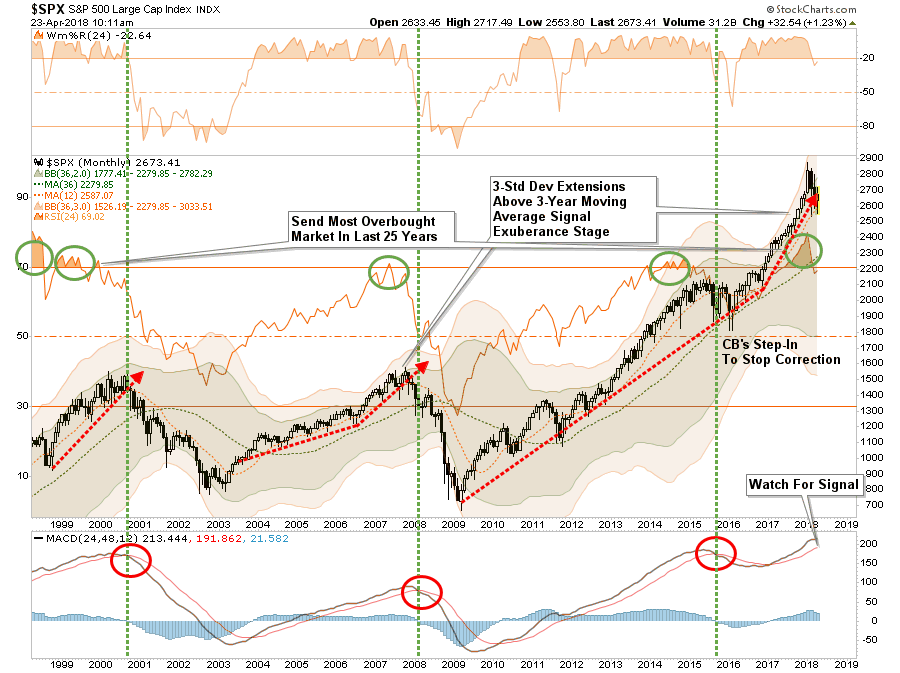
Weekly Stochastics
The question of “timing” is where speeding up our measures to a “weekly” basis provides more beneficial analysis. In this analysis we look at the 1-year full Stochastic Oscillator. Via Stockcharts.com:
Developed by George C. Lane in the late 1950s, the Stochastic Oscillator is a momentum indicator that shows the location of the close relative to the high-low range over a set number of periods. According to an interview with Lane, the Stochastic Oscillator ‘doesn’t follow price, it doesn’t follow volume or anything like that. It follows the speed or the momentum of price. As a rule, the momentum changes direction before price.
As shown by the vertical blue lines, “sell signals” from high levels, as we are at now, have been good predictors of both corrections and bear markets. The problem is that it doesn’t distinguish between the two. Therefore, as stated, it is best combined with the monthly and quarterly data above to confirm longer-term trends.
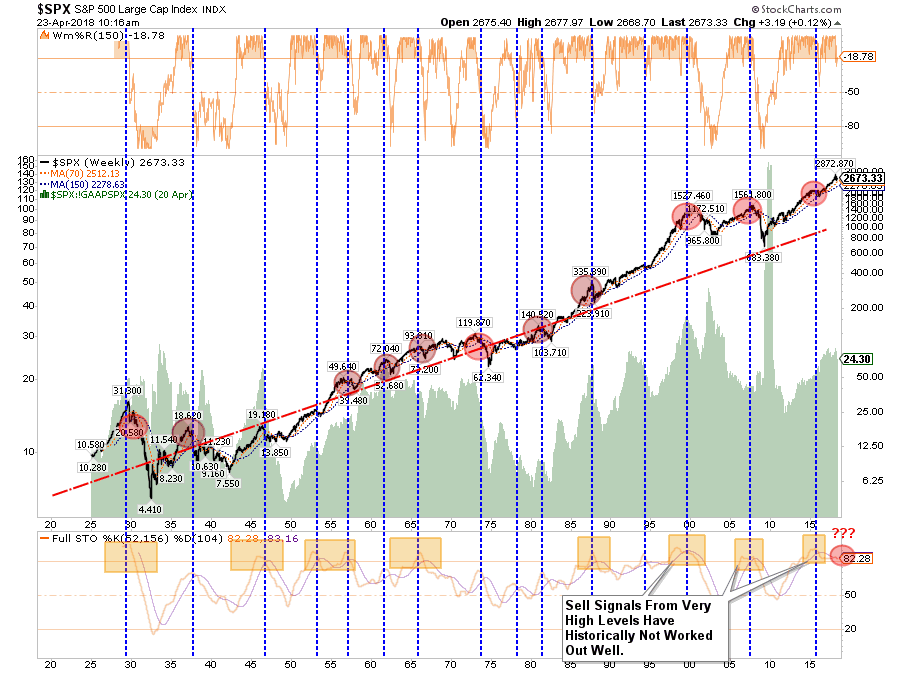
Putting It All Together
The chart below pulls all the measures above into a monthly chart. We also add two more confirming indicators – the Coppock Curve and the Ultimate Oscillator. Via Stockcharts.com:
The Coppock Curve is a momentum indicator developed by Edwin ‘Sedge’ Coppock, who was an economist by training. Coppock introduced the indicator in Barron’s in October 1965. The goal of this indicator is to identify long-term buying opportunities in the S&P 500. The signal is very simple. Coppock used monthly data to identify buying opportunities when the indicator moved from negative territory to positive territory.
The Ultimate Oscillator, developed by Larry Williams in 1976, is a momentum oscillator designed to capture momentum across three different time-frames. The multiple time-frame objective seeks to avoid the pitfalls of other oscillators. Many momentum oscillators surge at the beginning of a strong advance and then form a bearish divergence as the advance continues. This is because they are stuck with one time-frame. The Ultimate Oscillator attempts to correct this fault by incorporating longer time-frames into the basic formula.
What is most important about technical analysis is not to rely solely on one indicator. Such can, and often does, lead to false signals that can impair performance over time though higher volatility, turnover, and emotional wear. This is especially the case with shorter-term signals (daily and weekly) which tends to lead to the assumption that price analysis doesn’t work. However, when several indicators begin to produce the same signals, that “confirmation” provides for a more reliable outcome. (Note that I said “more reliable” not “perfect.”)
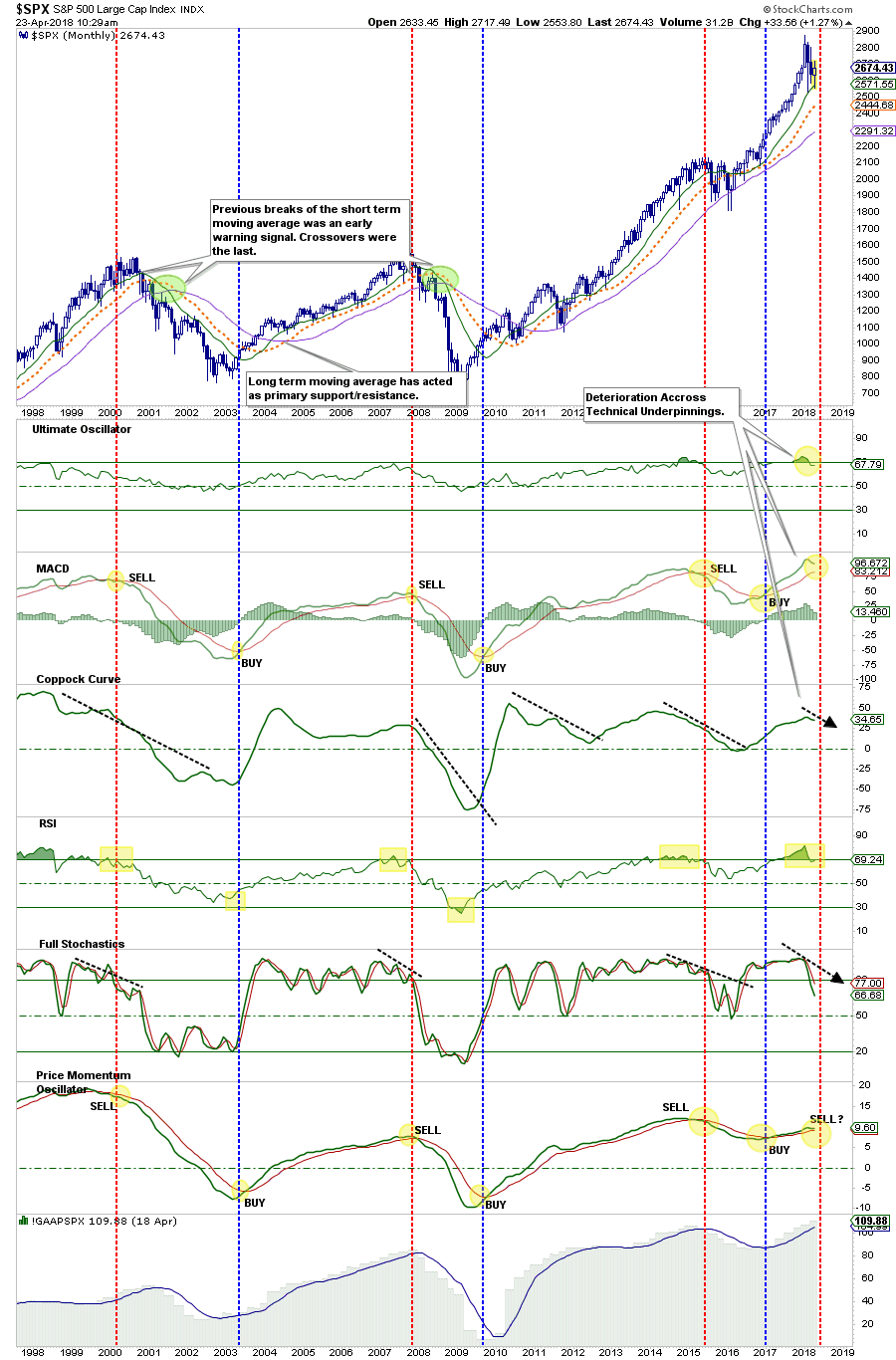
Conclusion
With more and more signals on a longer-term basis all sending the same message, investors should be substantially more cautious. This is particularly the case when those longer-term signals are combined with excessively high valuations combined with weak economic growth and rising interest rates. Historically, the combination of these events has led to rather horrible outcomes for investors over the longer-term.
If the market is going to reverse these signals, and reinstate the longer-term bullish trend, the “bulls” need to re-engage immediately and push prices to new highs. However, the longer the market continues to languish, the risk of a deeper correction rises markedly.
Let me restate that we currently maintain short-term equity exposure to the markets as the bullish trend that begin in 2009 remains intact. However, we currently holding a higher level of cash than normal as a hedge against volatility and the lack of a positive risk/reward backdrop with which to deploy “risk” capital.
As I stated in “8-Reasons To Hold Cash:”
I am suggesting that holding higher levels of cash during periods of uncertainty provides both stability and opportunity. With the fundamental and economic backdrop becoming much more hostile toward investors in the intermediate term, understanding the value of cash as a ‘hedge’ against loss becomes much more important.
Just remember that while markets are typically irrational in the short-term, they often become rational quicker than you can “sell” in the long-term.
Which stock should you buy in your very next trade?
AI computing powers are changing the stock market. Investing.com's ProPicks AI includes 6 winning stock portfolios chosen by our advanced AI. In 2024 alone, ProPicks AI identified 2 stocks that surged over 150%, 4 additional stocks that leaped over 30%, and 3 more that climbed over 25%. Which stock will be the next to soar?
Unlock ProPicks AI
